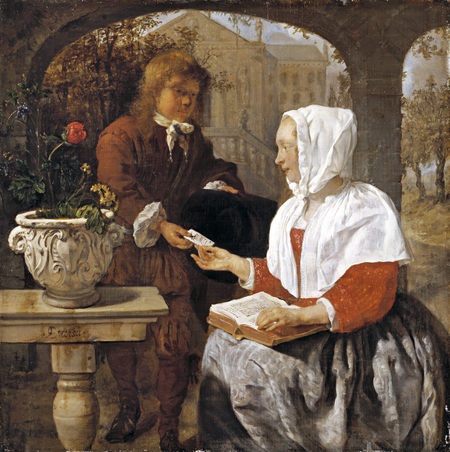We probably all have some familiarity with the situation pictured here. Waiting to receive word from a loved one, we seek to control our outward appearance but, internally, a sense of anxious expectation pervades. In our mind’s eye, we can imagine the other person, physically apart, but psychologically in sync with our thoughts. Reading their words promises to bring us close again. Even in our own era of instantaneous communication, the ellipses that foretell a coming text message are charged with their own version of this anticipation. Exchange maintains the important relationships in our lives. This is certainly the case today, when we are socially distanced from each other due to a pandemic and a few words of encouragement from our friends provide welcome reassurance.
Gabriel Metsu (1629-1667) seems to have understood these conditions. In his small--about 10 inches square--precise, painting entitled A Girl Receiving a Letter, the 17th-century Dutch artist uses his considerable pictorial skills to underscore the ways in which bodies are joined by words. In this case a simple letter is exchanged. The missive has yet to be fully transferred, however. At the left a young boy, too young to be the likely author of the letter, steps onto a covered porch and presents the sealed correspondence. A neatly-dressed woman looks up from her bible, and takes the letter in her delicate fingers. Ink is visible on the outside of the paper and she likely recognizes the handwriting. We sense the contents matter to the recipient. Tension circulates within the brightly lit scene--even the flowers in the stone urn at left arc inquisitively toward the impending hand off. The boy gazes at the woman with something like concern in his eyes. She looks only at the folded paper. Is its message the one she is hoping for?
The Timken picture represents a part of a larger story. Another painting, virtually the same size, is now at the Musée Fabre in Montpellier, France. In that work, Metsu depicted a man seated at a table, drafting what might well be the letter that appears in our painting. To his right, a female servant holding a candle illuminates the dark scene. The expression on the writer’s face is intense. He seems not to mind the clutter around him. We sense his earnestness and that he is lost in his thoughts while he crafts the sentiments that will soon be read by his beloved. A leading scholar of Metsu’s work, Frank Robinson, has argued that the Man Writing a Letter (also c. 1658) and A Girl Receiving a Letter must be understood as a pair. Indeed, according to Robinson, and others, Metsu represented himself as the man in the Montpellier painting and his wife, Isabella, was the model for the woman who now lives in San Diego. Both are exemplary works of the fijnschilders (fine painting) tradition of the Leiden School into which Metsu was born and in which he was trained, at least until he was in his mid-twenties, before he moved to Amsterdam. In both works, the careful observation of minute details of everyday life is typical of the artist. Metsu painted letter writers, and letter readers, on numerous occasions.
When Man Writing a Letter and A Girl Receiving a Letter were first created, they were understood to be in deep dialogue with one another. The two works might have been arranged on a single wall, a few feet between them at most, as they signaled their interest in sharing thoughts across time and space. Now, they are separated by oceans. Their messages, while unknown, seem full of purpose and strive to connect us still.
